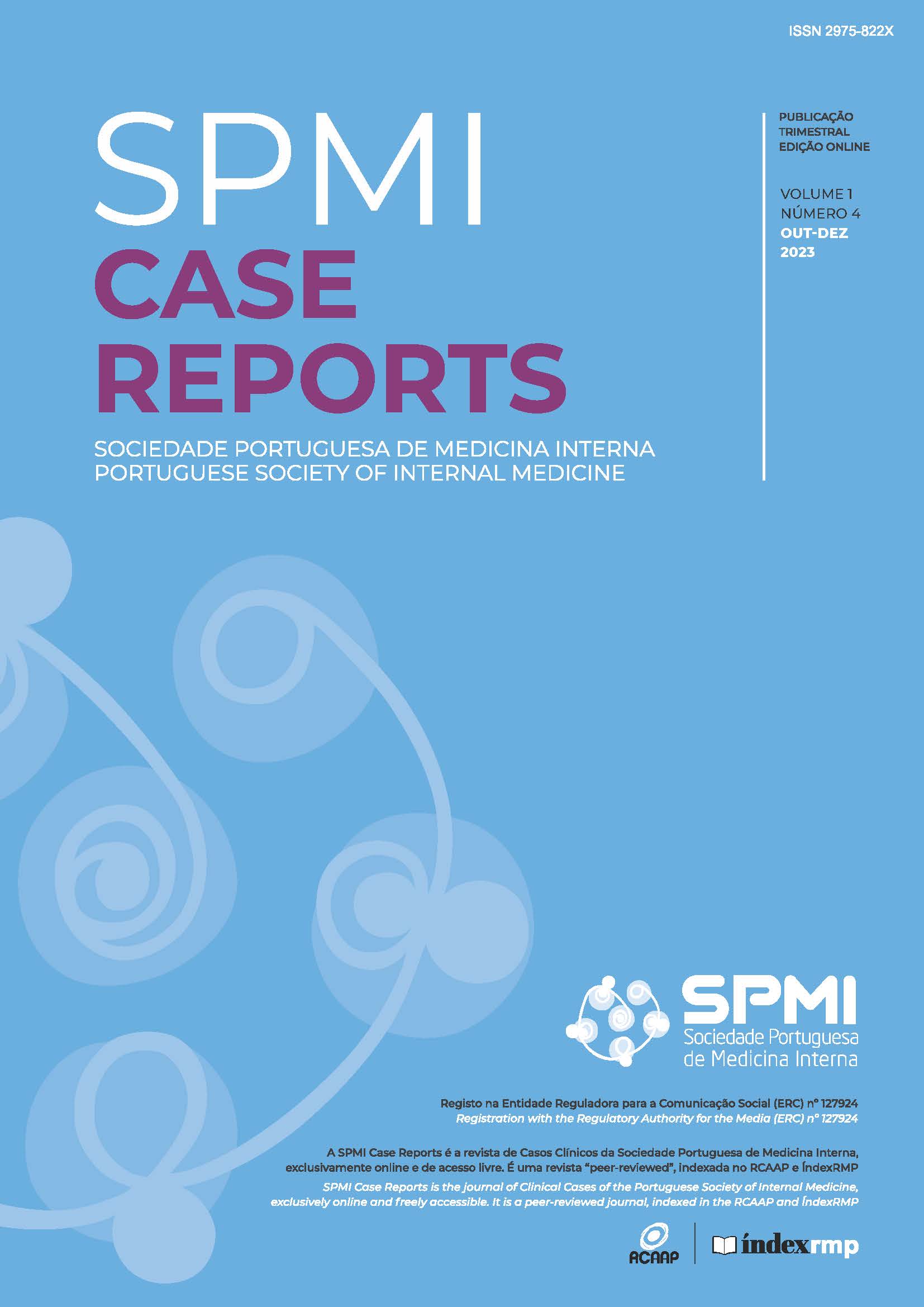Familial Amyloid Polyneuropathy: A Hereditary Disease, Not Always with Known Family History
DOI:
https://doi.org/10.60591/crspmi.132Keywords:
Amyloid Neuropathies, Familial, Peripheral Nervous System, PolyneuropathiesAbstract
Peripheral neuropathies are one of the most common neurological disorders in clinical practice. Its differential diagnosis is vast and includes familial amyloidotic polyneuropathy (FAP), a rare and multisystemic disease, whose diagnosis has important implications for the patient and his family. Despite being hereditary, with autosomal dominant transmission, its high phenotypic variability associated with incomplete penetrance makes very atypical presentations possible. The lack of family history adds complexity to the diagnostic process.
The authors present the case of a 59-year-old woman with carpal tunnel syndrome and no relevant family history who was referred to an Internal Medicine Consultation due to distal sensory-motor polyneuropathy, with a 1-year evolution and gradual progression. The neurological alterations found in the objective examination, given the normality of the analytical study, justified the performance of an electromyogram, nerve biopsy and genetic study, which confirmed the diagnosis of FAP.
Downloads
References
Çakar A, Durmuş-Tekçe H, Parman Y. Familial amyloid polyneuropathy. Noro Psikiyatr Ars. 2019;56:150-6. doi: 10.29399/npa.23502.
João S. Polineuropatia amiloidótica familiar: uma revisão bibliográfica; 2016. [consultado Jan 2022] Disponível em: https://repositorio-aberto.up.pt/handle/10216/88132.
Adams D, Ando Y, Beirão JM, Coelho T, Gertz MA, Gillmore JD, et al. Expert consensus recommendations to improve diagnosis of ATTR amyloidosis with polyneuropathy. J Neurol. 2021;268:2109-22. doi: 10.1007/s00415-019-09688-0.
Parman Y, Adams D, Obici L, Galán L, Guergueltcheva V, Suhr OB, et al. Sixty years of transthyretin familial amyloid polyneuropathy (TTR-FAP) in Europe: where are we now? A European network approach to defining the epidemiology and management patterns for TTR-FAP. Curr Opin Neurol. 2016;29:S3-S13. doi: 10.1097/WCO.0000000000000288.
Sekijima Y, Ueda M, Koike H, Misawa S, Ishii T, Ando Y. Diagnosis and management of transthyretin familial amyloid polyneuropathy in Japan: red-flag symptom clusters and treatment algorithm. Orphanet J Rare Dis. 2018;13:6. doi: 10.1186/s13023-017-0726-x. Erratum in: Orphanet J Rare Dis. 2019;14:111.
Carroll A, Dyck PJ, de Carvalho M, Kennerson M, Reilly MM, Kiernan MC, Vucic S. Novel approaches to diagnosis and management of hereditary transthyretin amyloidosis. J Neurol Neurosurg Psychiatry. 2022;93:668-78. doi: 10.1136/jnnp-2021-327909.
Barroso FA, Judge DP, Ebede B, Li H, Stewart M, Amass L, et al. Long-term safety and efficacy of tafamidis for the treatment of hereditary transthyretin amyloid polyneuropathy: results up to 6 years. Amyloid. 2017;24:194-204. doi: 10.1080/13506129.2017.1357545.
Conceição I, Coelho T, Rapezzi C, Parman Y, Obici L, Galán L, et al. Assessment of patients with hereditary transthyretin amyloidosis - understanding the impact of management and disease progression. Amyloid. 2019;26:103-11. doi: 10.1080/13506129.2019.1627312.
Ferreira MA. Phenotypic Variability in Familial Amyloid Polyneuropathy: TTR modifiers in Caenorhabditis Elegans and Human Models; 2019. [consultado Jan 2022] Disponível em https://repositorio-aberto.up.pt/handle/10216/121022
Marques AS, Garcês MD. Polineuropatia Amilóide Familiar de início tardio: o desafio do diagnóstico. Rev Port Med Gera Fam. 2018; 34: 322–26. doi.org/10.32385/rpmgf.v34i5.11945
Rudolph T, Kurz MW, Farbu E. Late-onset familial amyloid polyneuropathy (FAP) Val30Met without family history. Clin Med Res. 2008;6:80-2. doi: 10.3121/cmr.2008.794.
Chapter 392: Peripheral Neuropathies. In: Goldman-Cecil. 26th ed. p.2489-2505.e1
Lee A, Fine NM, Bril V, Delgado D, Hahn C. Hereditary transthyretin amyloidosis: a case report. J Med Case Rep. 2022;16:248. doi: 10.1186/s13256-022-03437-0.
Adams D, Koike H, Slama M, Coelho T. Hereditary transthyretin amyloidosis: a model of medical progress for a fatal disease. Nat Rev Neurol. 2019;15:387-404. doi: 10.1038/s41582-019-0210-4.








